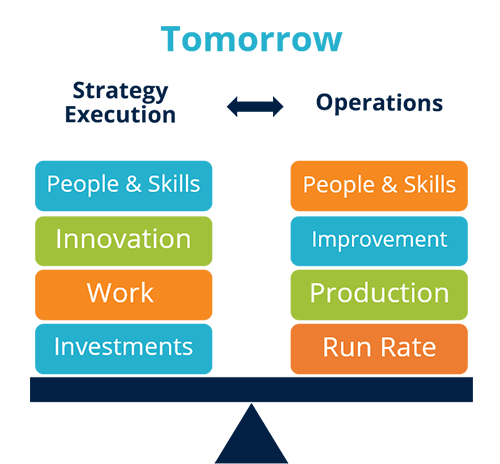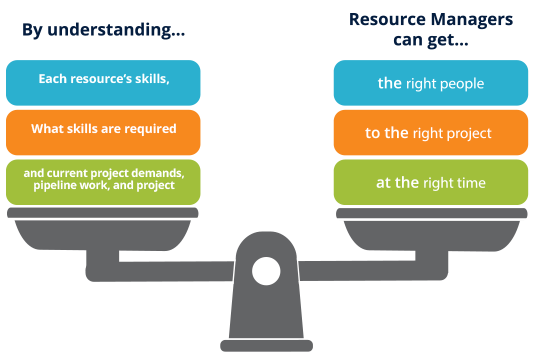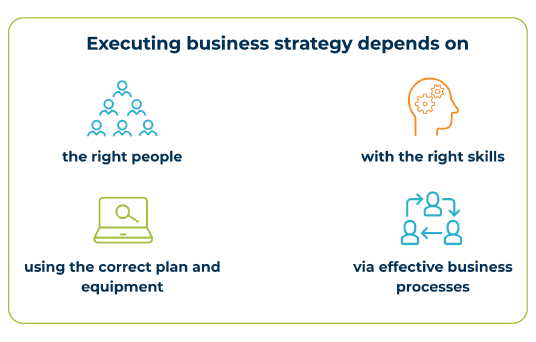Business leaders and resource managers do a never-ending dance to keep a company’s strategy, planning and execution aligned with constantly changing availability and workload of employees, goals, and outside factors.


Business leaders and resource managers do a never-ending dance to keep a company’s strategy, planning and execution aligned with constantly changing availability and workload of employees, goals, and outside factors. Part of that dance involves deciding how much to focus on the lofty goals and visionary ideas that can revolutionize a business, versus the daily needs to run a business. Those decisions on priorities also have to consider employees’ workload and future availability, how much room is in the budget to achieve these goals, deadlines and timing. To ensure leaders are focusing on strategy and not getting distracted by smaller project demands, a company often follows strategic portfolio management (SPM). In this guide, we’ll help define SPM, how resource management supports SPM, and how Tempus Resource can help you execute SPM successfully.

Strategic Portfolio Management is the process of creating a strategy for the entire business and building the supporting projects, products, roadmaps and plans to execute that strategy. SPM is designed to produce an executable plan. It’s not just about the strategy and important decisions, but also whether and how the work gets done. It’s the portfolio of work that will help your business achieve that strategy’s goals.
An advantage of using Strategic Portfolio Management is that all projects chosen to help execute a specific strategy must have a defined value. The value doesn’t need to be monetary; it simply needs to be measurable in some manner, so that your business leaders can determine whether the investments are moving the organization closer to achieving the strategic goal.


Our ability to finish projects and accomplish our goals is fundamentally determined by having qualified people. Without people, we can’t do work, we can’t execute projects, and we can’t implement strategy. Resource Management (RM) helps us most effectively utilize our people to achieve our business goals. RM helps match our supply of people (resource capacity) and our demand for people (resource allocation).
Championship teams start with a game plan. However, no team’s plan should remain unchanged throughout the course of a game. If faced with adversity, the coach must adapt their approach to the ‘real world’ circumstances – even if this means temporarily casting aside the original game plan. Redeploying resources to gain advantage is key. Real time adjustments are not only necessary but essential to winning.

This same analogy applies to businesses today. Redeploying people to gain a competitive advantage is key, and taking advantage of software and other tools that can easily show alternative scenarios can also help an organization’s competitive advantage. Being flexible and willing to reassign people under constraints and in line with new challenges is essential to achieving that business strategy. Naturally, your company should have an ultimate strategy, yet being able to adapt flexibly to the real world and its challenges is essential.

The core purpose of Strategic Portfolio Management is focusing on business strategy to guide decisions and get work completed. The core purpose of RM is effectively using resources to deliver on the organization’s strategy. How does RM support SPM?
For too long, organizations have failed to effectively manage the connection of resources and strategy – impacting their ability to create a sustainable competitive advantage. While this often manifests as a failure to deliver on a particular project, the unfortunate truth is that the longer-term effects negatively impact an organization’s ability to innovate, transform, and be profitable.

Resource Management takes Strategic Portfolio Management a step further and integrates the necessity of having the right people assigned to projects. Some organizations assume they can schedule people the same way they schedule machines or conference rooms, with the underlying belief being that people are generic within a category or business unit. At the earliest stages of capacity planning, resource managers focus on the big picture and understand each employee’s unique skillset and capacity to maximize portfolio success.


People often confuse demand management with SPM, but they are based on a very fundamental difference. Demand management assumes that a specific group of people in your company have the “right” to ask for work to be completed. SPM begins with the assumption that strategy drives the work that your people will do. A company must continue to invest in its strategy by focusing on the projects or products delivering value – financial or otherwise – that is greater than the investment.

Today, many organizations have created a hybrid system that we call gated-demand management. Under a gated-demand system, people in your company have a right to make an unlimited number of requests, but someone in another business unit has a right to decide if it is in the company’s best interest to do the work requested. In theory, this helps limit a large chunk of those “run the business” (RTB) activities, but in practice, too much time still gets taken for RTB projects.
Demand management thinking is biased toward RTB priorities, but it’s important that a business stay focused on its goals and strategy by implementing Strategic Portfolio Management. Most companies have between three and five well-defined strategies, and one of the strategies should be operational excellence, which means new investment in current operations. This means that an organization can decide upfront how much of a share of the investment pie the operational excellence “strategy” should receive. If you are practicing SPM instead of gated-demand management, you can set the RTB percentage consciously.



Start by listing the core elements of your organization’s strategy. Throughout this process it is critical to consistently make sure your people, projects and strategy are aligned.

What can you deliver? Understanding how many and what types of people and their roles you have is critical. This step is crucial to understand how much of your strategy can be done. At this stage, you should begin to quantify your organizational capabilities. You must also consider how constrained you will be when you assess your existing workload along with your new project pipeline.

Next, list all projects currently underway along with high-level resource forecasts. At this point, detailed project schedules and tasks are too in the weeds. What’s important is understanding resource utilization, or how much work your people are doing at any given time, including work that is forecasted but not yet begun.

With data assembled, you can now assess the reality of your delivery capabilities. Are you – already, without factoring in new projects – hopelessly over-utilized? Or – as unlikely as it may seem – drowning in excess capacity of your employees? It’s less likely that you have resources hanging around and twiddling their thumbs, so it’s more realistic that you fall into the over-allocated camp.
Depending on the state of your resource portfolio at this step, you may be constrained. Talk of introducing new projects from the pipeline may be moot. You may have so many resource constraints that at this step you have to consider which projects to kill or cancel, in which case, you would continue to Sub-Step 2: Develop Options. If, on the other hand, you do have capacity, you should analyze the effect of introducing new projects. With the right tools, you should be able to ask questions like “what if we do proposal A or proposal B” and so on.
An option is a security that grants you the right – not the obligation – to do something. By deploying the right tools, you should be able to develop options for execution, which may include changing project timing, canceling, or putting projects on hold, adding new proposals to the mix, or changing how projects are resource allocated. This step is where true differentiation can take place and where the intersection of resource management and strategy takes stage.

A central theme of Strategic Portfolio Management is the need to be dynamic and be able to alter course quickly. Constantly re-evaluating and assessing the impact of your strategy on your people is a requirement, not an option.
Organizations must constantly reevaluate, develop options, and ask questions. When we factor in the growing demands of modern business, no organization can afford to formulate a model at the beginning of the year and just stick with it. The model must be frequently re-evaluated and scenarios must be crafted to ensure your goals are met and projects are completed on time.

Whether your goal is to innovate, drive transformation, or improve profitability in record time, your teams must become efficient practitioners of Resource Management to experience portfolio success. To do so, you need a specialized solution designed with resource managers in mind.
Tempus Resource is the answer. There is no one-size-fits-all solution to solve all complex business problems. But, with Tempus Resource, enterprises are cutting their response time to new work in half and increasing the number of completed projects. How? Tempus Resource lets you define your individual people’s capacity and then immediately compares that to the project demands. Resource and Portfolio Managers can plan with roles, skills or people, analyze the impact of that plan and empower managers to run the options up the chain of command. Imagine being able to deliver scenarios and forecasts that actively show the impact of the business strategy on the people. We have seen this work before. Companies that use solutions that focus on Resource Management, like Tempus Resource, see improved results and more advancement in areas like organization, process, overall governance, and skills management.
Resource Managers and business leaders who are not currently using Tempus but are interested in exploring its features can arrange a demo with the Tempus team by visiting https://www.prosymmetry.com/schedule-demo.
Business leaders and resource managers do a never-ending dance to keep a company’s strategy, planning and execution aligned with constantly changing availability and workload of employees, goals, and outside factors.
Tempus Resource by ProSymmetry is a purpose-built, resource portfolio management solution providing many Fortune 500 companies with resource forecasting and capacity planning solutions that inform strategic decisions and improve business agility. Tempus gives Resource Managers actionable intelligence, cutting-edge analytics, and real-time scenario analysis. To schedule a demo of Tempus, click the button below.